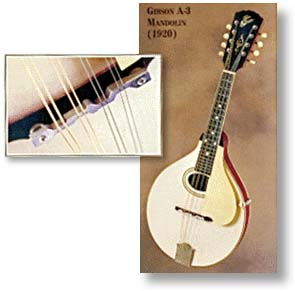Gibson A-3 Mandolin(1920)
 MAKING ITS DEBUT IN THE 1902 Gibson catalog was the modestly priced pear-shaped A-3 mandolin. This simple instrument was usually finished natural, although several black-top versions have been seen. In 1918, a new version was introduced with a distinctive white ivory-finish top and matching ivoroid pickguard. Aside from the black-faced instruments that Gibson had been marketing from its beginnings, the white-faced A-3 was probably the first “custom color” American instrument, something quite prevalent in today’s electric guitar market. This example from late 1920 also came equipped with the first adjustable ("patent applied for") bridge, complete witha unique aluminum saddle, producing a loud banjo-like sound. The aluminum bridge saddle was replaced by an ebony one in late 1921, although at least one player, the great vaudevillian Dave Apollon, must have liked the sound because he is often pictured playing the later F-5 model mandolins with an aluminum saddle.
MAKING ITS DEBUT IN THE 1902 Gibson catalog was the modestly priced pear-shaped A-3 mandolin. This simple instrument was usually finished natural, although several black-top versions have been seen. In 1918, a new version was introduced with a distinctive white ivory-finish top and matching ivoroid pickguard. Aside from the black-faced instruments that Gibson had been marketing from its beginnings, the white-faced A-3 was probably the first “custom color” American instrument, something quite prevalent in today’s electric guitar market. This example from late 1920 also came equipped with the first adjustable ("patent applied for") bridge, complete witha unique aluminum saddle, producing a loud banjo-like sound. The aluminum bridge saddle was replaced by an ebony one in late 1921, although at least one player, the great vaudevillian Dave Apollon, must have liked the sound because he is often pictured playing the later F-5 model mandolins with an aluminum saddle.
(from Tone Poems II CD booklet , used by permission)
Photography by D. Brent Hauseman